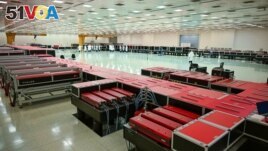03 April 2024
Engineer Antonia Toma works at a research center in Romania that holds one of the world's most powerful operating lasers.
Recently, Toma studied the controls responsible for starting the laser.
"Ready? Signal sent!"

The room where the laser beam of the "Extreme Light Infrastructure-Nuclear Physics"- ELI-NP laser is produced is pictured in Magurele city near Bucharest, Romania, March 26, 2024. (Photo by Daniel Mihailescu/ AFP)
The engineer spoke to the French News Agency about her work at the center near the capital, Bucharest.
"I will not lie. From time to time, things can get a little stressful," the 29-year-old said.
"But it's also very joyful to work here. And we are very happy that we have results" as teams of international researchers come to the center, she added.
‘Incredible odyssey'
European scientists hope the technology used in the laser will bring improvements to fields like health and space.
The French company Thales operates the laser.
The laser is so powerful because of technology that was awarded the 2018 Noble Prize in Physics. Gerard Mourou of France and Donna Strickland of Canada were among three who shared the award that year. The Nobel Academy noted that improving laser technology offered new ways "for deepening our knowledge about the world and shaping it."
Mourou spent 30 years working in the United States. Then he went to Europe to complete the laser project. The effort began in the 2000s as part of the European Union's Extreme Light Infrastructure (ELI) project. ELI is a research group with two other high-powered lasers, one in the Czech Republic and one in Hungary.
The 79-year-old Mourou said the laser starts with a small amount of light with very little energy. But it is designed to amplify, or increase, its energy millions of times.
Scientists have aimed to create more powerful lasers for many years. The devices fire extremely powerful beams of light, which can be used for medical, industrial and military purposes.
By the mid-1980s, however, scientists had reached a limit. They could not increase the power of the laser without destroying part of the system.
Mourou and his then-student Strickland invented a technology called Chirped-Pulse Amplification (CPA). They developed the technology at the University of Rochester in the American state of New York.
CPA increases the laser's power while keeping the system safe. The method is complex. It works by stretching a short laser pulse with optical parts. Then, CPA uses special materials to amplify the pulse millions of times. Finally, the pulse is compressed, so that it lasts for an extremely short period: as short as one millionth of one billionth of a second.
Today, doctors use the same technology to correct people's eyesight with laser surgery. Mourou said it could also be used in medicine to destroy cancer cells.
The age of the laser
Mourou predicts that the 2000s will be the century of the laser. Additional scientific uses for CPA could include direct observation of the motion of atoms, reducing radioactivity of nuclear waste and removing debris from space.
Franck Leibreich is a managing director at Thales. He said it took hundreds of metric tons of equipment to build the laser in Romania at a cost of about $350 million. The EU helped pay for much of it. Thales said the laser is the largest investment ever made in scientific research in Romania.
Countries including France, China and the United States are also developing their own projects to build even more powerful lasers.
I'm Andrew Smith.
Andrew Smith adapted this story for VOA Learning English based on reporting from Agence France Press.
__________________________________________________
Words in This Story
stressful –adj. something that causes mental or physical pressure or tension
pulse –n. a short, regular beat or surge of sound, electricity or material in a system
optical –adj. related to the part of physics that relates to the nature and properties of light
compress –v. to make shorter or smaller by a physical method such as force
surgery –n. a medical operation
debris –n. the remains of structures or materials that have broken down or fallen apart